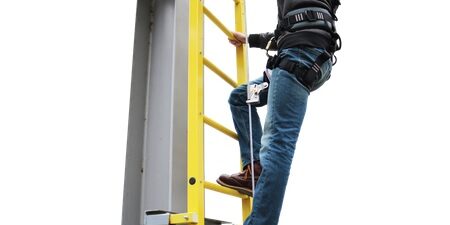Roofers are used to climbing ladders to gain access to jobs. Let’s talk about the fixed ladders we use to get to the hatch or roof deck. Contractors can help building owners navigate the rocky path that is fixed ladders for either internal (roof hatch) or external (roof access) usage. In the past, the questions would consist of “Do we need a cage? Will this require a well? What type of handrails? Does this extend over an existing parapet?”
This all changed when OSHA 1910.28(b)(9) was amended in November of 2018. Now, cages are no longer considered fall protection on ladders that are longer than 24’ above a lower level. 1910.28(b)(9)(i)(A) states “For existing ladders installed prior to November 19, 2018, that extend more than 24’ above a lower level, they must be equipped with a personal fall arrest system, ladder safety system, cage or well.”
Furthermore, 1910.28(b)(9)(i)(B) states fixed ladders installed after November 19, 2018, are equipped with a personal fall arrest system or ladder safety system. If any portion of the ladder is replaced, it now must be equipped with a personal fall arrest system or ladder safety system. On and after November 18, 2036, all fixed ladders are equipped with a personal fall arrest system or a ladder safety system (1910.28(b)(9)(i)(D).
That’s not a typo, after November 18, 2036, ALL fixed ladders that are longer than 24’ above a lower level, regardless of installation date, must be brought up to code.
So now that we know cages and wells can’t be the sole source of fall protection, let’s look at what OSHA defines as acceptable. Per OSHA’s website:
Ladder Safety System: a system attached to a fixed ladder designed to eliminate or reduce the possibility of a worker falling off the ladder. A ladder safety system usually consists of a carrier, safety sleeve, lanyard, connectors, and body harness.
With the options available to the contractor, this appears to be the most uniform application. And while all roofers should be familiar with personal fall arrest systems, there is a change in how the harness may operate. 1910.140(d)(1)(iv) states with regards to performance that the system must “sustain the employee within the system/strap configuration without making contact with the employee’s neck and chin area.” This means that most traditional harnesses used in conjunction with a self-retracting lifeline or fall arrest anchor may not meet the standard for a fixed access ladder system. There are harnesses available with a waist mounted dee ring that would satisfy the requirements.
If you have questions about fixed access ladders or ladder safety systems, we can help. With over 70 years of experience and 5 locations throughout the country, Roofmaster has and continues to help contractors build America.






